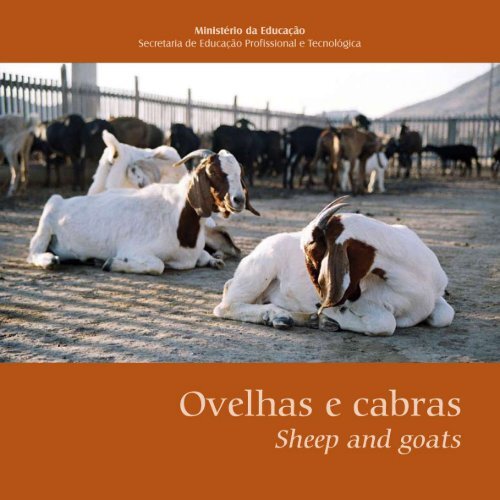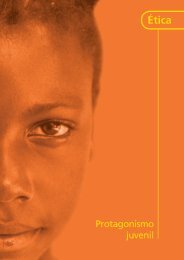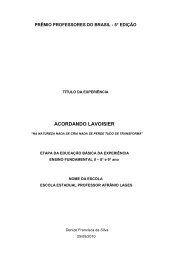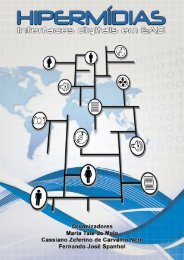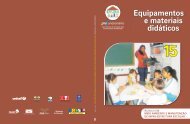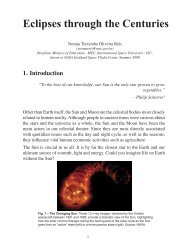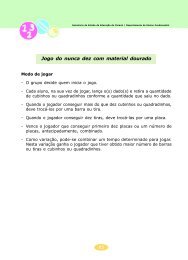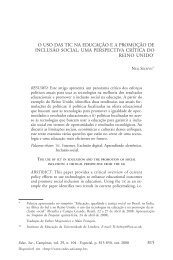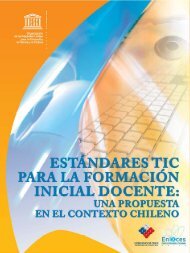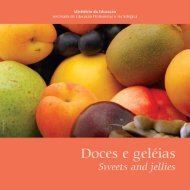Ovelhas e cabras - Portal do Professor - Ministério da Educação
Ovelhas e cabras - Portal do Professor - Ministério da Educação
Ovelhas e cabras - Portal do Professor - Ministério da Educação
You also want an ePaper? Increase the reach of your titles
YUMPU automatically turns print PDFs into web optimized ePapers that Google loves.
<strong>Ovelhas</strong> e <strong>cabras</strong> Sheep and goats<br />
<strong>Ministério</strong> <strong>da</strong> <strong>Educação</strong><br />
Ministry of Education<br />
Secretaria de <strong>Educação</strong> Profissional e Tecnológica<br />
Professional and Technological Education Secretariat<br />
Brasília, novembro de 2007<br />
Brasília, November 2007<br />
<strong>Ovelhas</strong><br />
e <strong>cabras</strong><br />
Sheep and goats
2<br />
Cartilhas Temáticas Thematic Pamphlets
<strong>Ovelhas</strong> e <strong>cabras</strong> Sheep and goats<br />
Apresentação / Presentation<br />
Com entusiasmo, a Secretaria de<br />
<strong>Educação</strong> Profissional e Tecnológica<br />
(Setec) publica, em 2007, mais<br />
quatro cartilhas temáticas. Cria<strong>da</strong>s há<br />
<strong>do</strong>is anos para apresentar os resulta<strong>do</strong>s<br />
<strong>da</strong> articulação <strong>da</strong> política de formação de<br />
trabalha<strong>do</strong>res <strong>do</strong> <strong>Ministério</strong> <strong>da</strong> <strong>Educação</strong><br />
com as ações empreendi<strong>da</strong>s por setores<br />
produtivos locais, esses volumes mostram<br />
alguns aspectos <strong>do</strong> trabalho realiza<strong>do</strong> por<br />
escolas <strong>da</strong> rede federal em colaboração com<br />
empreende<strong>do</strong>res brasileiros.<br />
As experiências mostra<strong>da</strong>s nesses volumes<br />
– relaciona<strong>da</strong>s à cultura <strong>do</strong> cupuaçu, à<br />
produção de <strong>do</strong>ces e geléias, à criação de<br />
ovelhas e <strong>cabras</strong> e à cadeia produtiva de<br />
rochas ornamentais – resultam <strong>da</strong>s políticas<br />
de educação, geração de trabalho e ren<strong>da</strong> <strong>do</strong><br />
Governo Federal destina<strong>da</strong>s a combater as<br />
profun<strong>da</strong>s desigual<strong>da</strong>des sociais brasileiras.<br />
Os textos aqui apresenta<strong>do</strong>s mostram<br />
um pouco <strong>da</strong> história <strong>do</strong> país, os cursos<br />
ofereci<strong>do</strong>s pelas escolas federais de educação<br />
profissional e também as pesquisas setoriais<br />
desenvolvi<strong>da</strong>s por pesquisa<strong>do</strong>res brasileiros.<br />
Há, em alguns deles, ain<strong>da</strong>, receitas pitorescas<br />
ou populares. Esperamos que tenham, ao<br />
lê-los, a mesma satisfação e orgulho que os<br />
gestores <strong>da</strong> Secretaria de <strong>Educação</strong> Profissional<br />
e Tecnológica tiveram ao decidir publicá-los.<br />
Setec/MEC<br />
In 2007, the Professional and Technical Education Secretariat (Setec) takes pleasure in publishing four more thematic<br />
informative bulletins. Created two years ago to present the results of the workers training policies developed by<br />
the Ministry of Education together with actions undertaken by local productive sectors, these volumes show some<br />
of the aspects of the work carried out by federally funded schools in collaboration with Brazilian entrepreneurs.<br />
The experiences shown in these volumes - related to cupuaçu crops, the production of sweets and jellies,<br />
raising sheep and goats and the production chain of ornamental rocks - are the result of education, jobs and<br />
income policies of the federal government to combat the profound social inequalities in Brazil.<br />
The texts presented here show some of our country’s history, the courses offered by federal professional<br />
schools and also the work in these areas by Brazilian researchers. Some of them even have unique and popular<br />
recipes. We hope that after reading them you will feel the same satisfaction and pride felt by the managers at<br />
the Professional and Technical Education Secretariat when they decided to publish them.<br />
Setec/MEC
Cartilhas Temáticas Thematic Pamphlets<br />
<strong>Ovelhas</strong> e <strong>cabras</strong> fortalecem<br />
economia <strong>do</strong> semi-ári<strong>do</strong><br />
Rebanho de ovinos e caprinos é de 25,8 milhões de cabeças no Brasil<br />
<strong>Ovelhas</strong> e <strong>cabras</strong> têm facili<strong>da</strong>de para se<br />
a<strong>da</strong>ptar a diferentes condições de solo, clima<br />
e vegetação, e essa versatili<strong>da</strong>de permite que<br />
esses animais sejam encontra<strong>do</strong>s em to<strong>do</strong>s os<br />
continentes. No mun<strong>do</strong>, os maiores cria<strong>do</strong>res<br />
de ovinos são a Austrália, a China e a Nova<br />
Zelândia, e de caprinos, a Índia, a China e<br />
o Paquistão.<br />
O rebanho brasileiro de ovinos e caprinos é<br />
de 25,8 milhões de cabeças no país, segun<strong>do</strong> o<br />
Censo Agropecuário* de 2005, <strong>do</strong> Instituto<br />
Brasileiro de Geografia e Estatística (IBGE).<br />
Esses números são inexpressivos, se considera<strong>da</strong><br />
a dimensão territorial e as condições de<br />
solo e clima brasileiros, favoráveis à criação<br />
desses animais no país. A região Nordeste<br />
detém 58% <strong>do</strong> rebanho de ovinos e 93% <strong>do</strong><br />
rebanho de caprinos <strong>do</strong> Brasil. Metade está<br />
concentra<strong>da</strong> em proprie<strong>da</strong>des menores <strong>do</strong> que<br />
30 hectares. No país, a Bahia tem o maior<br />
número de cabeças, com cerca de 2,5 milhões<br />
de ovinos e 4,2 milhões de caprinos.<br />
A produção desses animais é alternativa<br />
importante na oferta de carne e leite para as<br />
populações <strong>da</strong> zona rural brasileira. Na maioria<br />
<strong>do</strong>s esta<strong>do</strong>s, a ovinocaprinocultura ain<strong>da</strong><br />
é desenvolvi<strong>da</strong> de forma empírica e extensiva,<br />
sem a a<strong>do</strong>ção de práticas adequa<strong>da</strong>s de<br />
manejo nutricional e sanitário, por isso tem<br />
apresenta<strong>do</strong> baixos níveis de produtivi<strong>da</strong>de.
Sheep and Goats Strengthen<br />
Economy in Semi-Arid Region<br />
Brazil’s herds of sheep and goats have<br />
reached 25.8 million<br />
Sheep and goats a<strong>da</strong>pt easily to different soil, climate and vegetation<br />
conditions and this versatility allows these animals to be found on all<br />
continents. The world’s largest sheep herds are in Australia, China and<br />
New Zealand, and the largest goat herds are in India, China and Pakistan.<br />
Brazilian sheep and goat herds reached about 25.8 million head<br />
according to the 2005 Livestock Census* conducted by the Brazilian<br />
Geography and Statistics Institute (IBGE). These numbers are<br />
insignificant if one considers the size of the country and Brazil’s<br />
soil and climate conditions that favor raising these animals<br />
here. The northeastern region of the country has 58% of the<br />
sheep herds and 93% of the goat herds. Half of these herds<br />
are concentrated on properties with less than 30 hectares. The state of<br />
Bahia has the largest herds with about 2.5 million sheep and 4.2 million goats.<br />
<strong>Ovelhas</strong> e <strong>cabras</strong> Sheep and goats<br />
Raising these animals is an important alternative for the supply of meat and milk for populations in<br />
the rural zones of Brazil. In most states the raising of sheep and goats is still being carried out empirically<br />
and extensively, without a<strong>do</strong>pting adequate nutritional and sanitary management practices, and therefore<br />
productivity levels are low.<br />
*Censo Agropecuário / Livestock census<br />
Efetivo <strong>do</strong>s rebanhos – Cabeças (Brasil) / Current Herds – Head (Brazil)<br />
Rebanho / Herd 200 200 200<br />
Caprinos / Goats 9.581.653 10.046.888 10.306.722<br />
Ovinos / Sheep 14.556.484 15.057.838 15.588.041<br />
Fonte / Source: http://www.sidra.ibge.gov.br/b<strong>da</strong>/pecua/default.asp<br />
Pesquisa Pecuária Municipal (PPM) / Municipal Livestock Survey (PPM)
Cartilhas Temáticas Thematic Pamphlets
Capacitação<br />
<strong>Ovelhas</strong> e <strong>cabras</strong> Sheep and goats<br />
O cenário <strong>da</strong> ovinocaprinocultura no Brasil<br />
vem sen<strong>do</strong> modifica<strong>do</strong> pelo trabalho de instituições<br />
públicas e priva<strong>da</strong>s que buscam incentivar<br />
o crescimento <strong>da</strong> exploração racional <strong>do</strong>s<br />
ovinos e caprinos, seja por meio <strong>da</strong> difusão de<br />
novas tecnologias, seja através de transformações<br />
nas cadeias produtivas e de merca<strong>do</strong>. As<br />
escolas agrotécnicas federais têm importante<br />
papel na capacitação de produtores e técnicos<br />
e na difusão de técnicas adequa<strong>da</strong>s de criação<br />
que visem ao aumento <strong>da</strong> produtivi<strong>da</strong>de. A<br />
competição entre os merca<strong>do</strong>s produtivos tem<br />
provoca<strong>do</strong> uma busca por novos conhecimentos<br />
técnicos e gerenciais no setor.<br />
Education<br />
The sheep and goat raising scenario in Brazil<br />
is changing due to the work of public and private<br />
institutions that seek to encourage the rational<br />
expansion of sheep and goat raising by spreading<br />
new technologies through transformations in<br />
the productive chains and the market. Federal<br />
agricultural schools play an important role in<br />
training producers and technicians and in the<br />
dissemination of suitable techniques to increase<br />
productivity. Competition in the production markets<br />
has stimulated a search for new technical and<br />
management knowledge in the sector.<br />
7
Shutterstock<br />
Cartilhas Temáticas Thematic Pamphlets<br />
A Cabra foi o<br />
primeiro animal<br />
de produção<br />
<strong>do</strong>mestica<strong>do</strong><br />
pelo homem<br />
A cabra foi <strong>do</strong>mestica<strong>da</strong> há cerca de 6 mil<br />
anos e ain<strong>da</strong> hoje representa um <strong>do</strong>s principais<br />
animais de criação, contribuin<strong>do</strong> de forma<br />
significativa para a fixação <strong>do</strong> homem na zona<br />
rural. Caprinos e ovinos fornecem vários produtos<br />
importantes: leite, carne, couro, pêlo e<br />
esterco. Algumas vezes, <strong>cabras</strong> e ovelhas ain<strong>da</strong><br />
são utiliza<strong>da</strong>s como animais de tração.<br />
Paulo Emílio Rodrigues Donato, professor<br />
de Mecanização e Irrigação <strong>da</strong> Escola Agrotécnica<br />
Federal Antônio José Teixeira (EAFAJT),<br />
localiza<strong>da</strong> em Guanambi, Bahia, cria ovelhas<br />
desde 1987. Na Fazen<strong>da</strong> Alagoinhas, de 700<br />
hectares, ele mantém 400 cabeças de ovinos,<br />
<strong>da</strong>s raças Santa Inês e Suffolk, além de outras<br />
cem de bovinos. Na proprie<strong>da</strong>de, que fica no<br />
município de Sebastião Laranjeiras, Paulo diz<br />
que sua maior dificul<strong>da</strong>de com o manejo <strong>do</strong>s<br />
animais é o controle <strong>da</strong>s verminoses. Mesmo<br />
fazen<strong>do</strong> vermifugações a ca<strong>da</strong> 60 dias, ele tem<br />
ti<strong>do</strong> problemas. Seu pai sempre criou ovelhas<br />
e foi com ele que Paulo aprendeu a manejar os<br />
animais. “Quan<strong>do</strong> menino, sempre brincava<br />
com os bichos”, relembra.<br />
Sua experiência como professor lhe permite<br />
dizer que o aluno <strong>do</strong> curso técnico sai mais prepara<strong>do</strong><br />
na prática <strong>do</strong> que o forma<strong>do</strong> em cursos<br />
superiores <strong>da</strong> área, pois o contato com as criações<br />
é maior nos cursos de formação profissional.
Goats were the first<br />
production animal<br />
<strong>do</strong>mesticated by man<br />
Goats were first <strong>do</strong>mesticated about 6,000<br />
years ago and even to<strong>da</strong>y represent on of<br />
the main livestock animals and contribute<br />
significantly to the livelihood of populations in<br />
rural zones. Goats and sheep provide several<br />
important products: milk, meat, leather, wool and<br />
fertilizer. Sometimes sheep and goats are used<br />
as draft animals.<br />
Paulo Emílio Rodrigues Donato, professor of<br />
Mechanization and Irrigation at the Antônio José<br />
Teixeira Federal Agro-Technical School (EAFAJT),<br />
located in Guanambi, Bahia, has raised sheep<br />
since 1987. At Fazen<strong>da</strong> Alagoinhas, a 700-hectare<br />
farm, he raises 400 head of sheep with breeds<br />
such as Santa Inês and Suffolk, as well as 100<br />
head of cattle. Paulo says that on his property,<br />
which is located in the municipality of Sebastião<br />
Laranjeiras, the greatest difficulty in managing the<br />
animals is controlling worms. Despite deworming<br />
every 60 <strong>da</strong>ys, he still has problems. His father<br />
always raised sheep and Paulo learned about<br />
animal husbandry from him. “When I was a boy I<br />
always played with animals,” he remembers.<br />
His experience as a professor allows him to<br />
say that a student who completes the technical<br />
course is more prepared in practical matters than<br />
students that have graduated from universities<br />
in the area, since there is more contact with the<br />
animals at vocational schools.<br />
<strong>Ovelhas</strong> e <strong>cabras</strong> Sheep and goats
0<br />
Cartilhas Temáticas Thematic Pamphlets<br />
Diferenças<br />
Ovinos e caprinos são espécies cria<strong>da</strong>s em<br />
sistemas distintos e com a finali<strong>da</strong>de de oferecer<br />
produtos diferencia<strong>do</strong>s: carne – e pele<br />
e pêlos – ou leite.<br />
No semi-ári<strong>do</strong> nordestino, os ovinos<br />
deslana<strong>do</strong>s e os caprinos a<strong>da</strong>pta<strong>do</strong>s à região<br />
apresentam grande potencial para a produção<br />
de carne e pele. São bastante precoces,<br />
principalmente quan<strong>do</strong> submeti<strong>do</strong>s a um<br />
manejo nutricional diferencia<strong>do</strong>. A capaci<strong>da</strong>de<br />
produtiva <strong>da</strong> raça é inversamente relaciona<strong>da</strong><br />
à rustici<strong>da</strong>de. Os ovinos possuem<br />
Differences<br />
Sheep and goats are species raised in distinct<br />
systems, with the purpose of offering different<br />
products: meat – and leather or wool – or milk.<br />
In the semi-arid region of northeastern Brazil,<br />
sheep after shearing and goats a<strong>da</strong>pted to the<br />
region have a huge potential for the production of<br />
meat and leather. There produce early, mainly when<br />
submitted to differentiated nutritional management.<br />
A breed’s productive capacity is inversely related<br />
to its rusticity. Mutton is much better accepted
uma carne mais bem aceita pelo merca<strong>do</strong> e<br />
têm maior capaci<strong>da</strong>de de resposta a condições<br />
de criação melhora<strong>da</strong>s. Os caprinos, por<br />
outro la<strong>do</strong>, são mais a<strong>da</strong>pta<strong>do</strong>s à Caatinga<br />
e seus produtos são associa<strong>do</strong>s à identi<strong>da</strong>de<br />
territorial e à cultura local.<br />
Os ovinos e caprinos introduzi<strong>do</strong>s no<br />
Brasil pelos coloniza<strong>do</strong>res e cria<strong>do</strong>s de forma<br />
extensiva se multiplicaram largamente devi<strong>do</strong><br />
à rustici<strong>da</strong>de e facili<strong>da</strong>de de se a<strong>da</strong>ptarem<br />
às diversas condições de habitat. Essa diversi<strong>da</strong>de<br />
de ambiente no qual foram cria<strong>do</strong>s<br />
possibilitou o surgimento de algumas raças<br />
locais bastante rústicas e a<strong>da</strong>pta<strong>da</strong>s à região<br />
in the market and sheep are more responsive to<br />
improved livestock raising conditions. Goats, in the<br />
other hand, are more a<strong>da</strong>pted to the dry scrublands<br />
(Caatinga) and their products are associated with<br />
local identity and culture.<br />
Sheep and goats were introduced in Brazil by<br />
the colonizers and were extensively raised and<br />
widely multiplied due to their rusticity and ease of<br />
a<strong>da</strong>ptation to diverse habitats. This environmental<br />
diversity in which they were raised enabled some<br />
very rustic local breeds to arise and become<br />
a<strong>da</strong>pted to the region where they were developed.<br />
<strong>Ovelhas</strong> e <strong>cabras</strong> Sheep and goats<br />
onde foram desenvolvi<strong>da</strong>s, porém pouco<br />
produtivas. Existe também uma grande varie<strong>da</strong>de<br />
de raças melhora<strong>da</strong>s.<br />
As principais raças de caprinos indica<strong>da</strong>s<br />
para a criação na região semi-ári<strong>da</strong> nordestina<br />
são a Anglo-nubiana de corte, Boer,<br />
Moxotó, Canindé, Savana e Kalahari. Têm<br />
grande importância, também, os grupos<br />
raciais Marota, Reparti<strong>da</strong>, Gurguéia e SRD<br />
(sem raça defini<strong>da</strong>).<br />
As raças de ovinos de corte mais utiliza<strong>da</strong>s<br />
no Nordeste são: Santa Inês, Mora<strong>da</strong> Nova,<br />
Somalis Brasileira, Dorper e Cariri. O tipo SRD<br />
tem também bastante importância.<br />
However, their productivity is low. There are also a<br />
large variety of improved breeds.<br />
The main sheep breeds indicated for raising in<br />
the semi-arid northeastern region of Brazil are the<br />
Anglo-Nubian for meat, Boer, Moxotó, Canindé,<br />
Savana and Kalahari. The Marota, Reparti<strong>da</strong>,<br />
Gurguéia and SRD (undefined) breeds are also<br />
very important.<br />
The sheep breeds for meat most used in the<br />
Northeast are: Santa Inês, Mora<strong>da</strong> Nova, Somalis<br />
Brasileira, Dorper and Cariri. The SRD types are<br />
also quite important.
2<br />
Cartilhas Temáticas Thematic Pamphlets<br />
Produtos<br />
Os cruzamentos são realiza<strong>do</strong>s para a obtenção de animais<br />
mais produtivos que seus pais, devi<strong>do</strong> ao vigor híbri<strong>do</strong>.<br />
Em rebanhos comerciais, deve ser sempre a<strong>do</strong>ta<strong>do</strong> quan<strong>do</strong><br />
se quer aumentar a produtivi<strong>da</strong>de. Critérios defini<strong>do</strong>s na<br />
escolha <strong>da</strong>s raças ou de grupos raciais para o cruzamento<br />
devem, porém, ser segui<strong>do</strong>s. Existem raças com maior veloci<strong>da</strong>de<br />
de crescimento, mais indica<strong>da</strong>s para reprodutores<br />
machos, e raças com melhor fertili<strong>da</strong>de e habili<strong>da</strong>de materna,<br />
indica<strong>da</strong>s para as matrizes <strong>do</strong> rebanho.<br />
A maior parte <strong>do</strong>s cria<strong>do</strong>res de ovelhas e <strong>cabras</strong> vende os<br />
animais para corte. Cleidiane Nogueira Prates trabalha no<br />
Empório <strong>do</strong> Cabrito, localiza<strong>do</strong> na Central de Abastecimento<br />
de Guanambi. Aluna <strong>do</strong> curso de Zootecnia <strong>da</strong> EAFAJT, ela<br />
revela que vende, em média, R$ 60 de deriva<strong>do</strong>s de caprinos<br />
aos <strong>do</strong>mingos. Às segun<strong>da</strong>s e quintas-feiras, com movimento<br />
menor, faz entre R$ 20 e R$ 30. O box pertence à Associação<br />
Comunitária <strong>do</strong>s Produtores Rurais de Mocambinho<br />
(Acoprum), de Pin<strong>da</strong>í, na Bahia. No espaço tem de tu<strong>do</strong> um<br />
pouco, de espinhaço a paleta e costela de bode.<br />
O vencimento médio de um técnico em agropecuária é de cerca de <strong>do</strong>is salários mínimos, no<br />
oeste <strong>da</strong> Bahia. Quase a totali<strong>da</strong>de <strong>do</strong>s alunos <strong>da</strong> EAFAJT é emprega<strong>da</strong> nessa região, principalmente<br />
nas ci<strong>da</strong>des de Barreiras, Correntina, Luís Eduar<strong>do</strong> Magalhães e Ro<strong>da</strong> Velha, onde a agricultura<br />
empresarial é forte, como explica o diretor <strong>da</strong> escola, Ariomar Rodrigues <strong>do</strong>s Santos.<br />
Maria Isaura <strong>da</strong> Silva Batista, ex-presidente <strong>da</strong> associação, está atualmente no cargo de<br />
diretora administrativa <strong>da</strong> Acoprum. Assim como Cleidiane, também estu<strong>da</strong> Zootecnia na<br />
EAFAJT. Ela conta que a associação de 27 pequenos produtores começou em 1995 e que a<br />
priori<strong>da</strong>de para a caprinocultura somente foi defini<strong>da</strong> <strong>do</strong>is anos depois.
Products<br />
<strong>Ovelhas</strong> e <strong>cabras</strong> Sheep and goats<br />
Cross breeding is carried out to obtain the most productive animals in their countries, due to hybrid vigor.<br />
In commercial herds, cross breeding should be a<strong>do</strong>pted when the aim is to increase productivity. However,<br />
criteria determined in the choice of breeds or groups of breeds for cross breeding may be followed. There are<br />
breeds with faster growth rates, those more indicated a male reproducers, and breeds with better fertility and<br />
maternal vitality, recommended as reproducers.<br />
Most sheep and goat breeders sell the animals for their meat.<br />
Cleidiane Nogueira Prates works at the Goat Emporium located<br />
in the Guanambi Food Supply Center. As an animal science<br />
student at EAFAJT, she reveals that she sells an average of R$60<br />
worth of products derived from goats on Sun<strong>da</strong>ys. Mon<strong>da</strong>y<br />
through Thurs<strong>da</strong>y, when there is less demand, she makes<br />
between R$20 and R$30. Her stand is owned by the Mambinho<br />
Community Rural Products Association (Acoprum) in Pin<strong>da</strong>í,<br />
Bahia. Her stand has a bit of everything – all kinds of goat meat.<br />
The average pay for an animal husbandry technician<br />
is about twice the minimum monthly wage in<br />
western Bahia. Almost all of the students at EAFAJT<br />
are employed in this region, mainly in the cities of<br />
Barreiras, Correntina, Luis Eduar<strong>do</strong> Magalhães and<br />
Ro<strong>da</strong> Velha, where corporate agriculture is strong,<br />
as explained by the school’s director Ariomar<br />
Rodrigues <strong>do</strong>s Santos.<br />
Maria Isaura <strong>da</strong> Silva Batista, former president<br />
of the association, is currently the administrative<br />
director of Acoprum. Like Cleidiane, she is also a<br />
student of animal science at EAFAJT. She says that<br />
the association has 27 small producers and began<br />
in 1995 and its focus on goat raising only<br />
began two years later.
Cartilhas Temáticas Thematic Pamphlets<br />
Feira <strong>do</strong> Bode<br />
Incentiva<strong>do</strong>s por programa <strong>da</strong> Pastoral <strong>da</strong> Terra, seis famílias <strong>da</strong> região ganharam dez<br />
matrizes e um reprodutor ca<strong>da</strong>, com devolução prevista para <strong>do</strong>is anos. Entusiasma<strong>da</strong>s, 24<br />
dessas famílias foram buscar financiamento no Banco <strong>do</strong> Nordeste, no final de 1998. No<br />
ano seguinte, to<strong>do</strong>s estavam cui<strong>da</strong>n<strong>do</strong> de seus animais e, em 2000, a Acoprum tinha um<br />
rebanho de 250 animais.<br />
“Não conseguimos, entretanto, fazer ven<strong>da</strong>s em grupo. Por isso, criamos a Feira <strong>do</strong><br />
Bode de Pin<strong>da</strong>í, em abril de 2001”, lembra Isaura. A feira virou uma pequena exposição e<br />
o Serviço Nacional de Aprendizagem Rural (Senar) ensinou os produtores <strong>da</strong> associação,<br />
no mesmo ano, a processar a carne, fazer cortes especiais, defumar e preparar embuti<strong>do</strong>s.
Goat Fair<br />
Encourage by the Land Pastoral program, six<br />
families from the region received one male and<br />
one female reproducer, with returns forecast to<br />
begin in two years. Excited about the idea, 24 of<br />
these families sought financing from the Banco <strong>do</strong><br />
Nordeste at the end of 1998. The following year they<br />
were all taking care of their animals and in 2000,<br />
Acoprum had a herd of 250 animals.<br />
“However, we were unable to make sales as a<br />
group. That’s why we created the Pin<strong>da</strong>í Goat Fair<br />
in April of 2001,” says Isaura. The fair turned into a<br />
small exposition and the National Rural Education<br />
Service (Senar) taught the producers in the<br />
association, in the same year, how to process meat,<br />
make special cuts, smoke the meat and prepare<br />
<strong>Ovelhas</strong> e <strong>cabras</strong> Sheep and goats<br />
Eles também aprenderam com os técnicos <strong>do</strong> Senar a fazer carne de sol e a aproveitar as<br />
vísceras <strong>do</strong>s animais. Depois, a associação conseguiu o ponto no merca<strong>do</strong> e passou a expor<br />
seus produtos para to<strong>da</strong> a região.<br />
Em outro ponto <strong>da</strong> Central de Abastecimento de Guanambi, o açougueiro Mário Pereira<br />
<strong>do</strong>s Santos trabalha com carnes de carneiro e de porco, pois, como diz, “a carne é mais barata<br />
e sadia”. Em seu quiosque, ele vende o quilo <strong>da</strong> carne de primeira (traseiro) por R$ 6 e o de<br />
segun<strong>da</strong> (dianteiro), por R$ 5.<br />
Também comerciante no merca<strong>do</strong>, a proprietária <strong>do</strong> Restaurante Serve Bem, Iraci Rosa<br />
de Matos, conta o segre<strong>do</strong> <strong>do</strong> preparo de seus pratos. “Tem que temperar a carne com coentro,<br />
cheiro verde, alho, cebola e sal. Para não ficar rançosa, é só aferventar a peça por 20<br />
minutos”, esclarece.<br />
sausages. They also learned from Senar technicians<br />
how to make sun-dried meat and to make use of<br />
the animals’ organs. Afterwards, the association was<br />
able to obtain an outlet in the market and began<br />
showing their products to the entire region.<br />
In another stand at the Guanambi Food Supply<br />
Center, butcher Mário Pereira <strong>do</strong>s Santos works with<br />
mutton and pork and as says, “both are cheaper and<br />
healthier.” At his stand he sells a kilo of prime cut<br />
for R$6.00 and sub-prime (hind quarter) for R$5.00.<br />
Another ven<strong>do</strong>r in the market, the owner of the<br />
Serve Bem Restaurant, Iraci Rosa de Matos, tells a<br />
secret for preparing her dishes. “You have to spice<br />
the meat with cilantro, green onions, garlic and salt.<br />
To remove any rancid o<strong>do</strong>r, just boil the meat for 20<br />
minutes,” she says.
Cartilhas Temáticas Thematic Pamphlets<br />
Escola forma profissionais para o setor<br />
A instituição, localiza<strong>da</strong> em Guanambi, no su<strong>do</strong>este <strong>da</strong> Bahia, mantém cursos técnicos nas<br />
áreas de Agricultura e Zootecnia. A formação de profissionais para atuar na ovinocaprinocultura<br />
tem contribuí<strong>do</strong> para o desenvolvimento <strong>do</strong> setor na Bahia.<br />
A escola tem instalações completas para a criação de rebanhos de ovinos <strong>da</strong> raça Santa<br />
Inês e caprinos <strong>da</strong>s raças Boer, Par<strong>da</strong> Alpina e Anglo-nubiana. São baias cobertas com acesso<br />
a solário e curral de manejo.<br />
Os animais são cria<strong>do</strong>s em regime semi-extensivo, com acesso a piquetes nativos de Caatinga<br />
e piquetes cultiva<strong>do</strong>s. Recebem suplementação mineral à vontade em cochos próprios e também<br />
suplementação volumosa – à base de capim elefante e silagem – e dieta concentra<strong>da</strong> balancea<strong>da</strong>.<br />
A EAFAJT mantém, ain<strong>da</strong>, um trabalho de extensão rural, prestan<strong>do</strong> assistência a pequenos<br />
e médios ovinocaprinocultores <strong>da</strong> região, nas áreas de nutrição, sani<strong>da</strong>de e reprodução,<br />
inclusive com inseminação artificial e detecção de prenhez por aparelho de ultra-som.<br />
School trains professionals<br />
for the sector<br />
The institution, located in Guanambi in the<br />
southeastern region of Bahia, has technical courses<br />
in Agriculture and Animal Science. Training these<br />
professionals to work in the sheep and goat breeding<br />
area has helped develop the sector in Bahia.<br />
The school has complete installations to raise<br />
herds of Santa Inês sheep and Boer, Par<strong>da</strong> Alpina<br />
and Anglo-Nubian goats. There are covered stalls<br />
with access to the sun and a handling corral.<br />
The animals are raised under a semi-extensive<br />
regimen with access to native hinterland<br />
vegetation and cultivated species. They receive<br />
mineral supplements in individual stalls and also a<br />
voluminous supplement of elephant grass and silage<br />
– a balanced diet.<br />
EAFAJT also has a rural extension program that<br />
provided assistance to small and medium goat<br />
and sheep breeders in the region, in the areas of<br />
nutrition, sanitation and reproduction, also with<br />
artificial insemination and detecting pregnancy by<br />
an ultrasound device.
<strong>Ovelhas</strong> e <strong>cabras</strong> Sheep and goats<br />
7
Cartilhas Temáticas Thematic Pamphlets<br />
Comi<strong>da</strong> de ruminante<br />
Os ovinos e caprinos são animais ruminantes,<br />
que têm os alimentos volumosos<br />
como base <strong>da</strong> dieta. Os suplementos minerais<br />
são de suma importância e a suplementação<br />
com alimentos concentra<strong>do</strong>s pode ser necessária.<br />
A elaboração <strong>da</strong> dieta depende <strong>do</strong><br />
sistema de criação e <strong>da</strong> época <strong>do</strong> ano.<br />
Ruminantes são mamíferos herbívoros<br />
que têm o estômago dividi<strong>do</strong> em quatro<br />
compartimentos. Depois de ingerir e mastigar<br />
a forrageira, esses animais regurgitam<br />
o alimento e remastigam. Assim, após a de-<br />
Food for Ruminants<br />
Sheep and goats are ruminants, whose basic<br />
diet consists of voluminous. Mineral supplements<br />
are particularly important and supplementation with<br />
concentrated feed may be necessary. Preparing the<br />
diets depends on the raising system and time of year.<br />
Ruminants are herbivorous mammals whose<br />
stomach is divided into four compartments. After<br />
ingesting and chewing the forage these animals<br />
regurgitate the food as cud and chew it again. Only<br />
after deglutination by the microorganisms in the
glutição, os microorganismos existentes no<br />
rúmen – o primeiro compartimento – fazem<br />
a digestão <strong>da</strong> fibra <strong>da</strong>s plantas, que, então,<br />
pode ser aproveita<strong>da</strong> pelo animal.<br />
Com duas estações defini<strong>da</strong>s no semi-ári<strong>do</strong>,<br />
uma chuvosa e outra seca, ovelhas e <strong>cabras</strong><br />
têm possibili<strong>da</strong>de de consumir dieta rica em<br />
nutrientes devi<strong>do</strong> à abundância de forragens<br />
na época <strong>da</strong>s chuvas. Não se deve esquecer <strong>da</strong><br />
suplementação mineral em cocho durante o<br />
ano inteiro. Na seca, matrizes e crias necessitam<br />
de alimentação diferencia<strong>da</strong>. A suplementação<br />
com dieta concentra<strong>da</strong> balancea<strong>da</strong><br />
(ração) pode ser a<strong>do</strong>ta<strong>da</strong>, também, quan<strong>do</strong> se<br />
deseja abater mais precocemente os animais.<br />
rumen – the first compartment – can the animals<br />
extract the nutrients in the food.<br />
With two different seasons in the semi-arid<br />
region, one rainy and one dry, sheep and goats<br />
are able to consume a diet rich in nutrients due<br />
to the abun<strong>da</strong>nce of forage during the rainy<br />
season. Year-round mineral supplements also<br />
cannot be neglected. During the dry season the<br />
female reproducers and lambs need different<br />
foods. Supplements and a concentrated balanced<br />
diet (feed) may be used when the intention is to<br />
slaughter the animals at an earlier age.<br />
<strong>Ovelhas</strong> e <strong>cabras</strong> Sheep and goats<br />
De acor<strong>do</strong> com a professora <strong>da</strong> EAFAJT,<br />
Ana Laura Borba de Andrade Gayão, mestre<br />
em Zootecnia, os alimentos volumosos<br />
para ovinos e caprinos podem ser pastagens<br />
nativas ou cultiva<strong>da</strong>s; culturas para a seca,<br />
como mandioca, cana-de-açúcar e palma<br />
forrageira; capineiras, principalmente<br />
capim-elefante; feno; silagem e resíduos<br />
agroindustriais. Em relação à pastagem nativa<br />
no Nordeste, a Caatinga representa uma<br />
excelente fonte de alimento para os animais<br />
na época chuvosa e podem ser a<strong>do</strong>ta<strong>do</strong>s<br />
tratos culturais que favoreçam a proliferação<br />
de espécies vegetais mais indica<strong>da</strong>s à<br />
alimentação <strong>do</strong>s ovinos e caprinos.<br />
According to EAFAJT professor Ana Laura Borba<br />
de Andrade Gayão, with a master’s degree in Animal<br />
Science, sheep and goats can graze on either<br />
native or cultivated pasturage. Plants for the dry<br />
season include manioc, sugarcane and forage palm;<br />
grasses, mainly elephant grass; hay; silage; and<br />
agro-industrial wastes. In relation to native pastures<br />
in the Northeast, the dry scrublands represent an<br />
excellent source of food for the animals during the<br />
rainy season, and plants may be cultivated that favor<br />
the proliferation of species that are better food for<br />
sheep and goats.
20<br />
Cartilhas Temáticas Thematic Pamphlets<br />
Manejo nutricional prevê<br />
satisfação <strong>da</strong>s necessi<strong>da</strong>des animais<br />
Para ca<strong>da</strong> fase de produção existem particulari<strong>da</strong>des no manejo nutricional que devem ser<br />
a<strong>do</strong>ta<strong>da</strong>s para o sucesso <strong>da</strong> criação. Desde a concepção até o desmame, o manejo alimentar<br />
deve contemplar as necessi<strong>da</strong>des de ca<strong>da</strong> categoria animal.<br />
As fêmeas <strong>do</strong>s ovinos e caprinos não devem ficar nem muito magras, nem muito gor<strong>da</strong>s,<br />
tanto à época <strong>da</strong> concepção quanto à <strong>do</strong> parto. As necessi<strong>da</strong>des nutricionais <strong>da</strong>s fêmeas nos<br />
primeiros cem dias de gestação são baixas. No terço final <strong>da</strong> gestação e na lactação, porém, as<br />
necessi<strong>da</strong>des protéicas aumentam e é recomen<strong>da</strong><strong>da</strong> a suplementação com feno de leguminosas<br />
ou alimentos concentra<strong>do</strong>s. Às fêmeas em crescimento, futuras matrizes, deve ser <strong>da</strong><strong>da</strong> especial<br />
atenção, sen<strong>do</strong> alimenta<strong>da</strong>s separa<strong>da</strong>mente <strong>da</strong>s adultas, pois têm necessi<strong>da</strong>des nutricionais<br />
diferentes e podem ter sua alimentação inibi<strong>da</strong> pelas adultas.<br />
O bode e o carneiro devem ser alimenta<strong>do</strong>s de mo<strong>do</strong> que não engordem excessivamente. A<br />
suplementação com concentra<strong>do</strong> balancea<strong>do</strong> deve ser a<strong>do</strong>ta<strong>da</strong> na época <strong>da</strong> estação de monta<br />
ou se o reprodutor estiver sen<strong>do</strong> muito utiliza<strong>do</strong>.<br />
O manejo nutricional <strong>da</strong>s crias depende <strong>do</strong> sistema de criação. Em um sistema semi-intensivo<br />
ou na seca, as crias permanecem com as mães por cerca de dez a 15 dias. Após esse<br />
perío<strong>do</strong>, ficam reti<strong>da</strong>s no aprisco e recebem duas amamentações diárias. Devem ter volumoso,<br />
concentra<strong>do</strong> e água à vontade.
<strong>Ovelhas</strong> e <strong>cabras</strong> Sheep and goats<br />
2<br />
Nutritional management to meet the animals’ needs<br />
For each phase of production there are<br />
particularities in nutritional management that should<br />
be a<strong>do</strong>pted for successful animal husbandry. From<br />
conception to weaning, food management should<br />
take into account the needs of each animal category.<br />
Female sheep and goats should not become<br />
very thin or very fat during both the time of<br />
conception and when giving birth. The female’s<br />
nutritional needs during the first 100 <strong>da</strong>ys of<br />
pregnancy are low. However, in the final third<br />
of the pregnancy and during lactation, protein<br />
needs increase and it is recommended to give<br />
supplements of leguminous hay<br />
or concentrated feed. Females<br />
during growth and future female<br />
reproducers should be given special attention by<br />
being fed separately from the adults, since their<br />
nutritional needs are different and they may have<br />
their feeding inhibited by the adults.<br />
The male goats and sheep should be fed in<br />
a manner that <strong>do</strong>es not fatten them excessively.<br />
Supplements with balanced feed should be a<strong>do</strong>pted<br />
during the breeding season or if the reproducer is<br />
being used often.<br />
Nutritional management of the lambs depends<br />
on the raising system. In a semi-intensive system<br />
or during the dry season, lambs remain with their<br />
mothers for about 10-15 <strong>da</strong>ys. After this period<br />
they remain in the pen and receive two breast<br />
feedings every <strong>da</strong>y. They should be fed<br />
grass, feed and water.
22<br />
Cartilhas Temáticas Thematic Pamphlets<br />
Consórcio<br />
O professor de Olericultura <strong>da</strong> EAFAJT,<br />
João Abel <strong>da</strong> Silva, mestre em Ciência e Tecnologia<br />
de Sementes, cria suas 60 cabeças de<br />
ovelhas Santa Inês em consórcio com frutas,<br />
principalmente manga e coco. Sua proprie<strong>da</strong>de<br />
de 12 hectares está localiza<strong>da</strong> no perímetro<br />
irriga<strong>do</strong> de Ceraíma.<br />
Para manejar o mato ao re<strong>do</strong>r de 300 mangueiras<br />
e 100 coqueiros, João Abel coloca as<br />
ovelhas para pastar. Os animais<br />
comem, ain<strong>da</strong>, concentra<strong>do</strong>s<br />
balancea<strong>do</strong>s mistura<strong>do</strong>s<br />
com cana e capimelefante.<br />
Ele revela<br />
que nem sempre<br />
o consórcio<br />
é um bom negócio,<br />
pois o capim hospe<strong>da</strong><br />
a cigarrinha, vetor<br />
de um agente que causa a<br />
seca <strong>do</strong> ponteiro <strong>do</strong> coqueiro,<br />
por exemplo. Nas terras<br />
imprestáveis para cultivos<br />
convencionais, ele planta<br />
palma forrageira, que utiliza<br />
para alimentar os animais.<br />
Abate<br />
As crias podem ser desmama<strong>da</strong>s entre 70 e<br />
90 dias de i<strong>da</strong>de. A duração <strong>da</strong> recria depende<br />
<strong>da</strong> meta <strong>da</strong> criação. Para animais para abate, a<br />
recria é realiza<strong>da</strong> até os animais atingirem cerca<br />
de 20kg. Para isso, devem receber volumoso<br />
de boa quali<strong>da</strong>de à vontade e, se necessário,<br />
complementação com concentra<strong>do</strong> balancea<strong>do</strong>.<br />
O ideal, porém, é que os animais de abate<br />
sejam desmama<strong>do</strong>s com peso adequa<strong>do</strong> para<br />
passarem direto à fase de acabamento.<br />
A terminação <strong>do</strong>s animais para abate pode<br />
ser realiza<strong>da</strong> no pasto ou em confinamento.<br />
Animais para corte podem ser produzi<strong>do</strong>s no<br />
pasto o ano inteiro, em sistema de criação<br />
sustentável. A utilização de pastagem nativa<br />
é possível quan<strong>do</strong> se desmamam as crias na<br />
época <strong>da</strong>s chuvas. Na seca, utiliza-se pastagem<br />
cultiva<strong>da</strong> ou irriga<strong>da</strong>.<br />
O melhor méto<strong>do</strong> de pastejo é o rotativo<br />
e a taxa de lotação depende <strong>da</strong> gramínea<br />
utiliza<strong>da</strong> e <strong>do</strong> desempenho espera<strong>do</strong> <strong>do</strong>s<br />
cordeiros e cabritos.<br />
O confinamento permite o abate mais<br />
precoce <strong>do</strong>s animais. É recomen<strong>da</strong><strong>do</strong> na época<br />
de escassez de forragens e, muitas vezes,<br />
é prática vantajosa para o acabamento de<br />
cordeiros e cabritos machos ou fêmeas com<br />
i<strong>da</strong>de em torno de 90 dias.
Mixed System<br />
EAFAJT organic gardening professor João Abel<br />
<strong>da</strong> Silva, who has a master’s degree in Seed Science<br />
and Technology, raises 60 Santa Inês sheep together<br />
with fruits, mainly mangos and coconuts. His 12hectare<br />
property is located in the irrigated perimeter<br />
of Ceraíma.<br />
In order to manage weeds around the 300<br />
mango trees and 100 coconut trees, João Abel puts<br />
sheep to pasture. The animals also eat balanced<br />
feed mixed with sugarcane and elephant grass.<br />
He says that a mixed system is not always a good<br />
business since the grass is a host for the cica<strong>da</strong>, a<br />
vector for an agent that causes dryness on the tips<br />
of the coconut trees, for example. On land that<br />
cannot be used for conventional crops, he plants<br />
forage palm and uses it to feed the animals.<br />
Slaughter<br />
<strong>Ovelhas</strong> e <strong>cabras</strong> Sheep and goats<br />
2<br />
Lambs may be weaned at between 70 and 90 <strong>da</strong>ys. This period depends on the objectives. For animals for<br />
slaughter, lambs should reach about 20 kg and therefore should receive voluminous amounts of good quality<br />
food, supplemented if necessary with balanced feed. However, ideally meat animals should be weaned at a<br />
weight that is adequate to pass directly to the finishing phase.<br />
The final phase for meat animals may be in the pasture or in confinement. Animals for slaughter may be<br />
produced in the pasture year round in a sustainable growth system. The use of native pasturage is possible<br />
when lambs are weaned during the rainy season. In the dry season, cultivated or irrigated pastures are used.<br />
The best grazing method is rotated, and the ratio of animals to pasturage depends on the grass used and<br />
the expected performance of the lambs.<br />
Confinement allows earlier slaughter. It is recommended during the time when forage is scare and many<br />
times this practice has advantages for the finishing phase of lambs with ages around 90 <strong>da</strong>ys.
2<br />
Cartilhas Temáticas Thematic Pamphlets<br />
Manejo sanitário<br />
é essencial para a<br />
saúde <strong>do</strong> rebanho<br />
O conhecimento <strong>da</strong>s condições fisiológicas<br />
e comportamento normais <strong>do</strong>s animais e a<br />
realização <strong>da</strong>s práticas básicas de manejo<br />
sanitário são imprescindíveis à manutenção<br />
de um rebanho saudável e produtivo.<br />
To<strong>do</strong>s os animais <strong>do</strong> rebanho devem ser<br />
vermifuga<strong>do</strong>s no início <strong>da</strong>s chuvas e de 60 em<br />
60 dias durante a seca. As fêmeas são trata<strong>da</strong>s<br />
no início <strong>da</strong> estação de monta e 30 dias antes <strong>do</strong><br />
parto. As crias recebem vermífugos três semanas<br />
após o primeiro contato com a pastagem.<br />
A vacinação contra febre aftosa não é obrigatória<br />
para ovinos e caprinos. O esquema<br />
de vacinação inclui proteção contra raiva,<br />
clostridioses, ectima contagioso e linfadenite<br />
caseosa. A incidência de <strong>do</strong>enças na região <strong>da</strong><br />
criação e a indicação de um médico veterinário<br />
determinam o esquema de vacinação.<br />
Da a<strong>do</strong>ção de técnicas eficientes de manejo<br />
reprodutivo depende o sucesso <strong>da</strong> produção<br />
de carne de ovino e caprino. A base<br />
de bons índices reprodutivos é a seleção de<br />
fêmeas precoces, que tenham atingi<strong>do</strong> 70%<br />
<strong>do</strong> peso adulto para a raça escolhi<strong>da</strong> e que<br />
sejam saudáveis.<br />
Fêmeas devem ser férteis, prolíficas e com<br />
boa habili<strong>da</strong>de materna, o que resulta em alta<br />
taxa de sobrevivência de crias ao desmame.
Sanitation management is<br />
essential for the herd’s health<br />
<strong>Ovelhas</strong> e <strong>cabras</strong> Sheep and goats<br />
2<br />
Knowledge of the physiological conditions and normal behavior of the animals, as well as basic sanitary<br />
management practices, are indispensable for maintaining a healthy and productive herd.<br />
All animals in the herd should be dewormed at the beginning of the rainy season and every 60 <strong>da</strong>ys<br />
during the dry season. Females should be treated at the beginning of the breeding season and 30 <strong>da</strong>ys after<br />
giving birth. Lambs should be treated three weeks after their first release to pasture.<br />
Vaccination against foot-and-mouth disease is not man<strong>da</strong>tory for sheep and goats. The vaccination<br />
should include protection against rabies, clostridiosis, contagious ectima and caseous lymphadenitis. The<br />
incidence of diseases in the breeding region and the recommen<strong>da</strong>tions of a veterinarian determine the<br />
vaccination schedule.<br />
The success of producing sheep and goat meat depends on a<strong>do</strong>ption of efficient reproduction<br />
management techniques. The basis of good reproduction rates is the selection of young females that have<br />
reached 70% of their adult weight for the breed chosen and that are healthy.<br />
Females should be fertile, prolific and have good mothering skills that result in high survival rate for<br />
lambs when weaned.
Shutterstock<br />
2<br />
Cartilhas Temáticas Thematic Pamphlets<br />
Mo<strong>do</strong> de preparo<br />
Receitas<br />
Pernil de cordeiro assa<strong>do</strong><br />
(<strong>da</strong> tradição popular)<br />
Ingredientes<br />
•<br />
•<br />
•<br />
•<br />
•<br />
•<br />
•<br />
•<br />
•<br />
•<br />
•<br />
•<br />
•<br />
•<br />
1 pernil de cordeiro;<br />
Suco de 1 limão;<br />
1 copo de vinho branco;<br />
1 cebola rala<strong>da</strong>;<br />
1 colher de sopa de vinagre;<br />
1 colher de sopa de sal;<br />
1 colher de chá de pimenta-<strong>do</strong>-reino;<br />
Cheiro verde pica<strong>do</strong>;<br />
1 pimenta malagueta pica<strong>da</strong>;<br />
2 dentes de alho pica<strong>do</strong>s;<br />
Folhas de louro;<br />
Manjerona pica<strong>da</strong>;<br />
Gordura vegetal;<br />
Manteiga.<br />
Misture to<strong>do</strong>s os temperos com o suco de limão e o vinho branco. Limpe bem o pernil e<br />
ponha com os temperos em uma vasilha na véspera. Vire o pernil de vez em quan<strong>do</strong>, para<br />
tomar bem o gosto <strong>do</strong>s temperos. No dia seguinte, limpe to<strong>do</strong>s os temperos e leve ao forno<br />
em uma assadeira, com a gordura, besuntan<strong>do</strong> com manteiga. Regue de vez em quan<strong>do</strong> com<br />
o molho até assar completamente.
Recipes<br />
Roast Leg of Lamb<br />
(a popular traditional dish)<br />
Ingredients<br />
•<br />
•<br />
•<br />
•<br />
•<br />
•<br />
•<br />
•<br />
•<br />
•<br />
•<br />
•<br />
•<br />
•<br />
1 leg of lamb<br />
Juice from 1 lime<br />
1 cup of white wine<br />
1 grated onion<br />
1 soupspoon of vinegar<br />
1 soupspoon of salt<br />
1 teaspoon of black pepper<br />
Diced parsley and chives to taste<br />
1 diced hot pepper<br />
2 cloves of diced garlic<br />
2 bay leaves<br />
Diced basil<br />
Vegetable oil<br />
Butter<br />
Preparation<br />
Mix all of the spices with the lime juice<br />
and white wine. Clean the leg of lamb well<br />
and cover it with the spices to marinate<br />
overnight. Turn the meat over several times<br />
so the spices will enter. The next <strong>da</strong>y clean<br />
all of the spices off and cook in a roasting<br />
pan with vegetable oil and butter. Baste often<br />
with the sauce until completely <strong>do</strong>ne.<br />
<strong>Ovelhas</strong> e <strong>cabras</strong> Sheep and goats<br />
27
2<br />
Cartilhas Temáticas Thematic Pamphlets<br />
Bahia<br />
Escola Agrotécnica Federal Antônio José Teixeira<br />
Zona Rural – Distrito de Ceraíma – CEP 46430-000 – Guanambi/BA<br />
Telefones / Phones: (77) 3493-2100 / 3493-2099 – Fax: (77) 3451-4144<br />
E-mail: dde@eafajt.gov.br – Homepage: www.eafajt.gov.br


